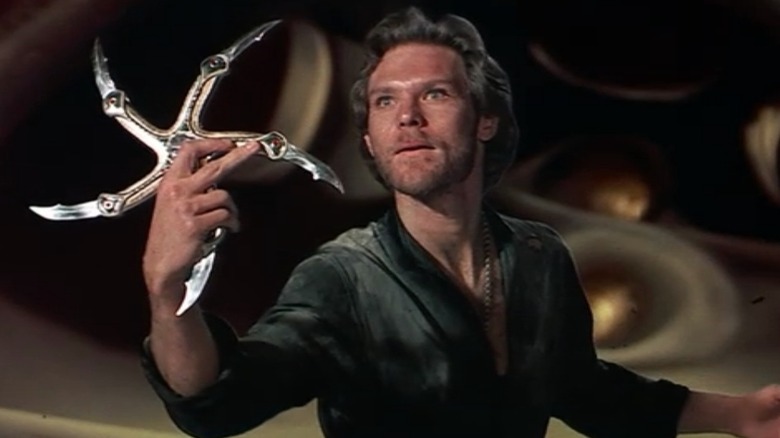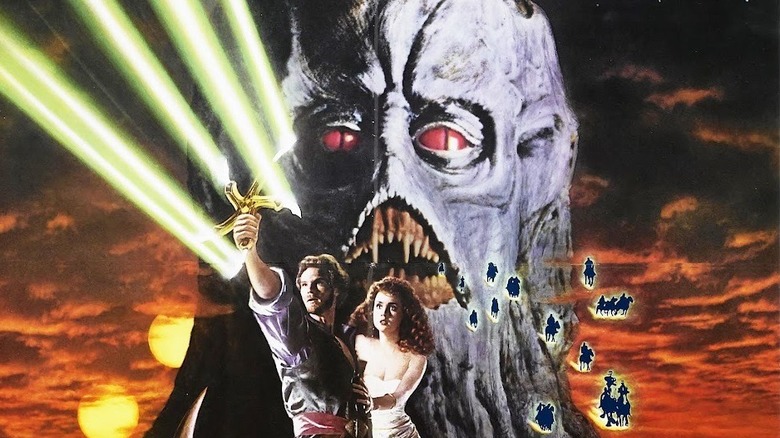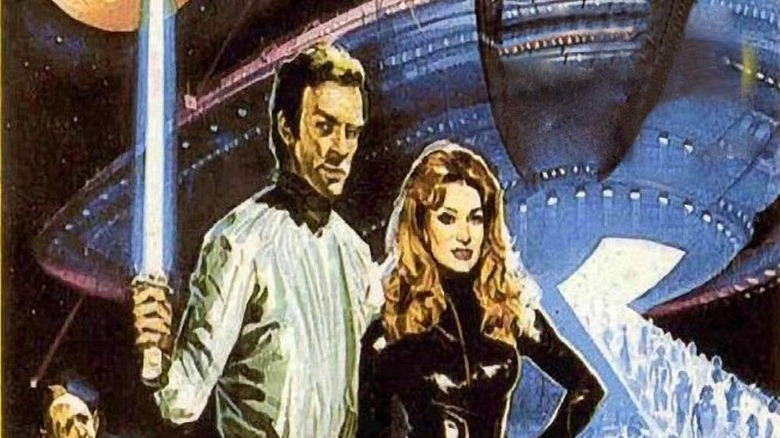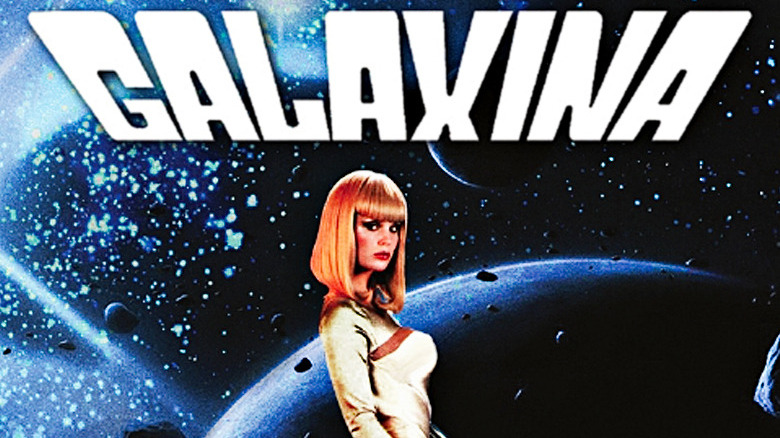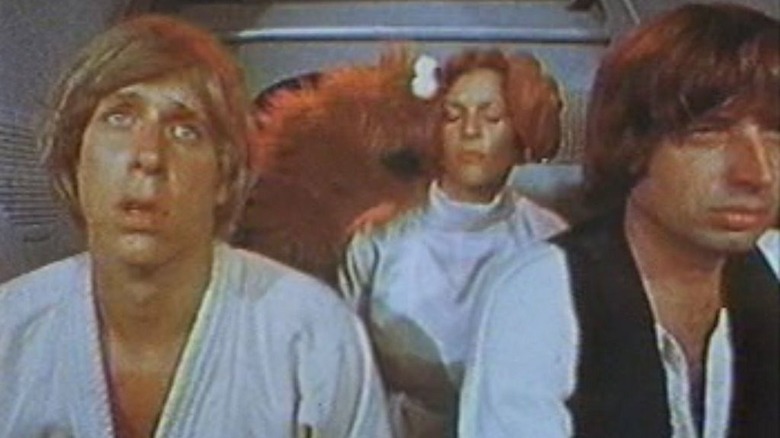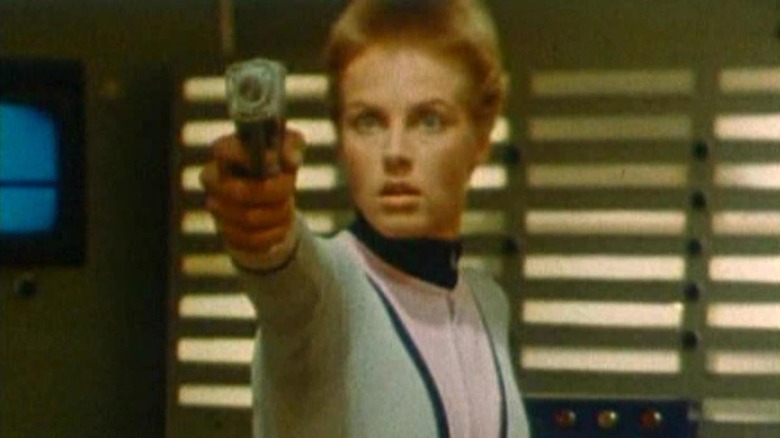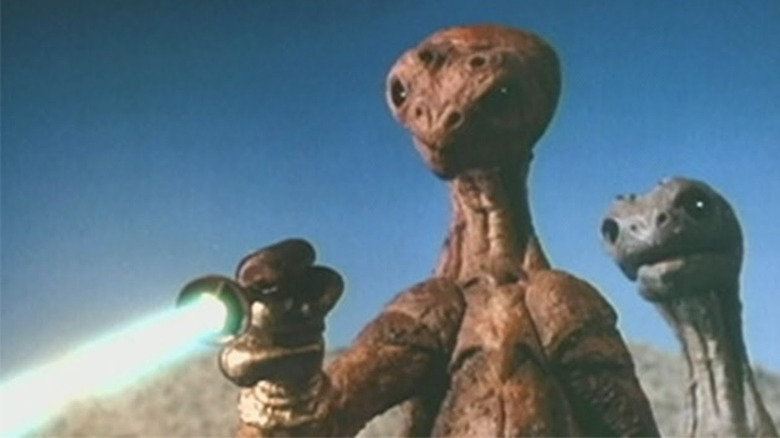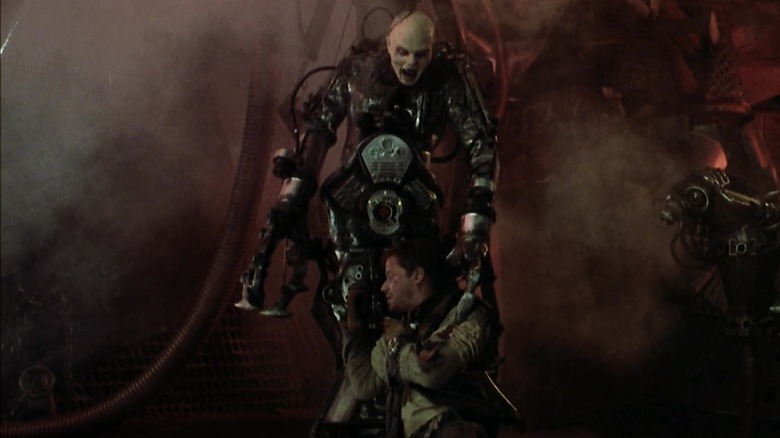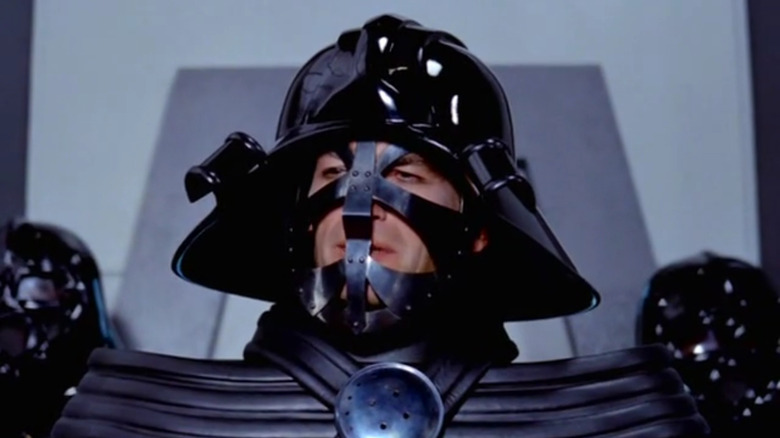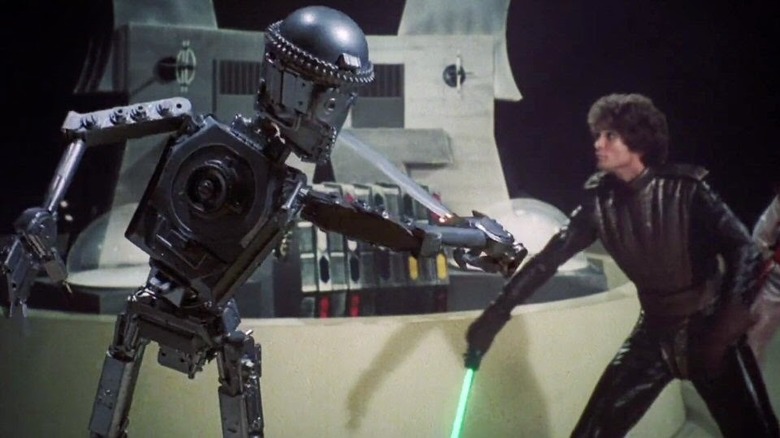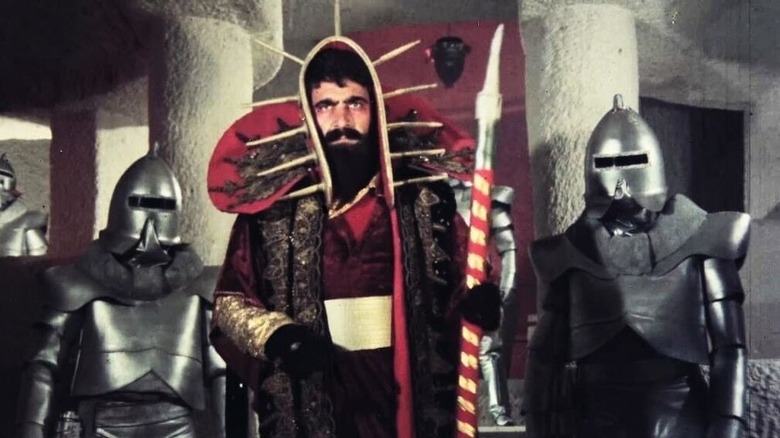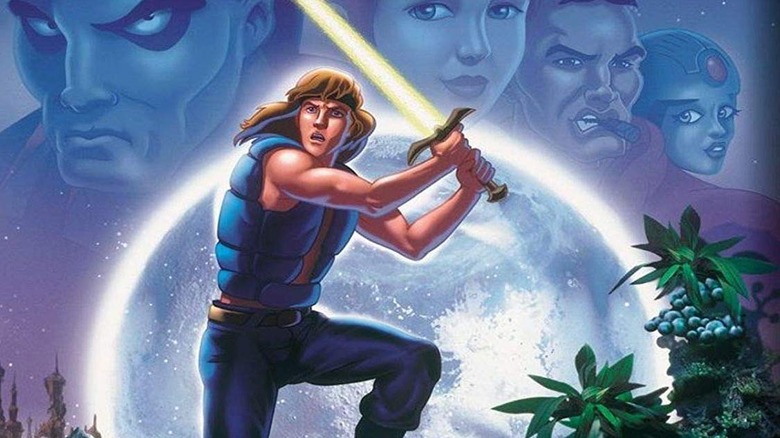The Strangest Star Wars Knock-Offs Of All Time
We may receive a commission on purchases made from links.
It's impossible to measure how impactful "Star Wars" has been on pop culture ever since it exploded into cinemas in 1977. The franchise itself is its own dynasty that comprises numerous sequels, prequels, spinoffs, television series, video games, and seemingly infinite merchandise. With plenty of other "Star Wars" projects currently in development, it's a safe bet the series will continue to dominate screens for quite some time. There are many other ways in which "Star Wars" has influenced the cultural landscape; "A New Hope" came out at a time when science fiction wasn't exactly trendy in the cinema, but it nonetheless reignited everyone's childhood fascination with space, aliens, and special effects-laden derring-do, cinematic hallmarks that continue to be popular in today's big-budget blockbusters.
If imitation is truly the sincerest form of flattery, then "Star Wars" has a veritable army of suitors. Once anything space-related had the potential to sell tickets in the wake of the "Star Wars" success, it wasn't long before countless filmmakers decided to take a crack at movies set in galaxies far, far away. What resulted from those rushed attempts to cash in was generally not good, due in no small part to the fact that most of those films straight up copied elements from the source of their inspiration rather than using it as fuel for other, more original ideas. Still, there are a lot of laughs to be had in these "Star Wars" knock-offs, so we've created a handy guide to some of the zaniest examples.
Krull (1983)
"Krull" tells the story of the title which is up next on the hit list of a malevolent godlike entity cleverly named Beast, whose favorite pastime is traveling to planets and conquering them. To prevent Beast and his army of Slayers from taking over the planet, Krull's two most powerful nations have formed an alliance made official by the marriage of their representatives, Prince Colwyn and Princess Leia ... or rather, Lyssa. However, when Lyssa is kidnapped by the Slayers, Colwyn must add "save princess" to his to-do list, just under "stop Beast," "fulfill ancient prophecy," and "be strikingly handsome at all times."
With a purported budget of $27 million, "Krull" is easily the most expensive film on this list. However, you'd think that a production with an even bigger budget than the paltry $11 million of "A New Hope" would be able to afford a screenwriter who could concoct a concept that wasn't simply "Star Wars: A New Hope Except It's Medieval." Then again, it was able to snag the late great Peter Yates as its director, who should be familiar to film fans for his impressive work on films like "Bullitt" and "Breaking Away." It's a pretty derivative story, but it makes for a fun sword and sorcery flick with the added bonus of an appearance from a young Liam Neeson.
Star Odyssey (1979)
Possibly to prevent any lawsuits, "Star Odyssey" director and co-writer Alfonso Brescia (credited as Al Bradley) decided to change one of the words in the title "Star Wars," then went on to narrowly dodge copyright infringement with the plot of the actual movie ... if you can call it a plot.
The film takes place in the far future when a group of aliens has become powerful enough to auction off planets as if they were in some sort of intergalactic Sotheby's. One particular alien jerk named Kress has won possession of Earth and is looking to gather up human slaves as part of an army he's building to sell to his space jerk friends. Malevolent, yes, but it's actually a pretty smart capital investment, as far as evil schemes go. However, a group of rebels form an alliance (ahem) and have made it their mission to prevent Kress and his cyborg horde from enslaving Earth's population. Can they succeed, even when a member of this motley crew is wearing a Spider-Man t-shirt for some reason? You bet your butt they can, and they'll do it while sticking up their middle fingers to the very concept of intellectual property itself.
Galaxina (1980)
Not even something as pure and wholesome as "Star Wars" could be spared from getting a raunchy R-rated satire, but "Galaxina" is packed with humor (both intentional and otherwise). The film takes place in the year 3008 and tells the story of the crew of a space police cruiser as they head home from a long mission. However, their return trip is interrupted when they're assigned the task of traveling to the planet Altar where they'll retrieve a magical gem. Oh, and among the crew is a sexy robot (played by Dorothy Stratten, the tragic 1980 Playboy Playmate of the Year) who starts to develop human emotions and is named Galaxina.
"Galaxina" makes references to numerous sci-fi and even western films, but "Star Wars" is its biggest influence. There's an opening crawl that sets up the main plot, a scene in a sleazy alien bar that viewers will instantly roll their eyes at, and plenty of other knowing winks to annoyed "Star Wars" fans. There are some pretty fun moments in "Galaxina," but most of the laughs from this sci-fi comedy come from when it's not trying to be funny. If you're in the mood for dated cornball humor taking place on flimsy futuristic sets, give this one a watch.
Hardware Wars (1978)
"Hardware Wars" is one of the first – if not the first – parodies of "Star Wars," beating Mel Brooks' "Spaceballs" by nearly a decade. Packed with visual puns and inside jokes designed to please the most hardcore "Star Wars" fans, this thirteen-minute long fan film replaced the lavish production values of its inspiration with common household objects and appliances for use as props and special effects. Despite the delightfully DIY filmmaking on display and the short runtime, "Hardware Wars" still manages to both follow and sendup the plot of "A New Hope," as the robots 4-Q-2 and Arty-Deco escape their attackers to land on a planet that looks suspiciously like a watermelon to deliver a video message from Princess Anne-Droid to Augie "Ben" Doggie, with help from Fluke Starbucker. To continue describing the plot would only spoil the countless jokes to be found in this short, so treat yourself and watch it here.
Because "Hardware Wars" doesn't take itself seriously, it actually comes off as surprisingly clever and self-aware, especially for a time when that sort of humor wasn't as common. To preserve the freshness of the film, its producer Ernie Fosselius wisely chose not to develop the film into something bigger, telling Salon that "at one time, someone did offer to finance a full-length feature of 'Hardware Wars,' but we passed. We always knew it was a one-joke movie and wouldn't sustain that length."
The War of the Robots (1978)
"Star Wars" made wars revolving around sci-fi concepts the new trend for the late-1970s, so it only makes sense that someone would come along and fill in the market gap with a flick about robots who war with one another. The result of this careful business analysis is "War of the Robots," which focuses on a pair of scientists — Lois and Carr — who have developed a way to manufacture any living creature they want and are creating a human being who can live forever. Such important science as this can't go unpunished, so the two scientists are kidnapped by an alien robot race that's on the verge of extinction and are forced into helping their captors revive their dying population. Can the brave and expressionless Captain John Boyd and his space crew save Lois and Carr? Yeah, probably.
Almost all of the films on this list were made with budgets that would probably amount to something in the double-digits today, even adjusted for inflation. However, "War of the Robots" doesn't just look like it was produced by filmmakers with little money, but by filmmakers who were in debt. That's to the film's credit, as it's the sincerity of the cast and crew that make it the charming trash heap it is. From cardboard spaceships to Halloween store costume design to laser swords that look like a toddler took a highlighter to the celluloid, there's plenty of cinematic cheese to go around.
Laserblast (1978)
While the overall plot of "Laserblast" has little in common with "Star Wars," it's proximity to the release date of that other sci-fi movie, a lead who is basically a deranged Luke Skywalker, and some direct references to "Star Wars" itself make the film more than qualified to be included on this list. "Laserblast" centers around a teenage boy named Billy who hates his life and the town he lives in. However, his life becomes cool when he stumbles upon an otherworldly laser cannon and pendant that were left behind by a mysterious green-skinned man who was killed by aliens. Billy puts on the cannon and discovers that it actually discharges powerful laser blasts, and it's not long before he gets his revenge on the people who've wronged him, all the while slowly turning into a bizarre alien creature.
On its surface, the creatively-titled "Laserblast" may not bear much of a resemblance to "Star Wars," but considering "A New Hope" made lasers and aliens and spaceships suddenly cool again, there's no doubt that this film was trying to capitalize on the renewed interest in science fiction. "Laserblast" even takes a pitiful swipe at its inspiration by including a scene wherein Billy points his laser cannon at a "Star Wars" billboard, blowing it to smithereens, with an onlooker exclaiming, "far out!" Think about this, "Laserblast" director: George Lucas never filmed a scene that features the Death Star obliterating a movie theater showing Akira Kurosawa's "The Hidden Fortress."
Spacehunter: Adventures in the Forbidden Zone (1983)
Director Lamont Johnson and his screenwriters went to great lengths to make sure that "Spacehunter: Adventures in the Forbidden Zone" was not influenced in any way by "Star Wars," and it shows. For example, "A New Hope" opens with a Rebel Alliance starship getting destroyed, whereas this film opens with a space cruise liner getting destroyed. Another point of distinction between the two films is that in "A New Hope" only one woman — Princess Leia — survived the destruction of her ship, while "Spacehunter" features three women surviving the destruction of their ship. See? Look closely and you'll spot even more differences. Did George Lucas ever cast a pre-"Sixteen Candles" Molly Ringwald in a "Star Wars" film? Didn't think so.
Anyway, the women land on a planet populated by grouchy locals and are taken captive into a zone that's quite forbidden, ruled by a powerful jerk called Overdog. A blue-collar space dude named Wolff catches the all-points bulletin on the missing women and the reward money for their safe return (3,000 mega-credits), promptly taking off with his female robot companion Chalmers. The filmmakers behind "Spacehunter" mostly just played Mad Libs with the plot of the first two "Star Wars" films and made something as fresh and unique as the line, "I've got a bad feeling about this."
The Humanoid (1979)
Taking place many tomorrows from now in our very own galaxy, "The Humanoid" tells the story of a futuristic utopian planet called Metropolis (previously identified as Earth) which is ruled by the benevolent Great Brother. The inhabitants of Metropolis live in peace and harmony, but that planetary tranquility is in danger now that the Great Brother's not-so-great brother Graal has an evil plan. Graal the Crappy Brother has broken out of space prison and has recruited the help of Dr. Kraspin, who has developed a way to turn regular peace-loving, free-thinking folk into supersoldier automatons that Graal plans on using to overthrow his brother and take over Metropolis. To start a clone war, if you will.
Director Aldo Lado was far too eager to cash in on the success of "Star Wars" with "The Humanoid." One can almost picture him sitting in the cinema taking notes from Lucas' film and forgetting that plagiarism is not the same thing as inspiration. "The Humanoid" opens up with a slow text crawl in space that explains the backstory of the film, and most of the intergalactic aesthetics are ripped directly from "A New Hope." Aldo even credited himself as George B. Lewis (sound familiar?). If you're not in the mood for imagination and originality, then give "The Humanoid" a watch.
Starcrash (1978)
Take the events of "Star Wars," put them into a blender along with a full-liter bottle of Everclear, then blend until smooth. That's how you make "Starcrash." This bizarre rehash/remix/regurgitation of "A New Hope" tells the story of fugitive space smugglers named Stella Star and Akton who stumble upon the sole survivor of an important mission to thwart the malevolent Count Zarth Arn from using a powerful planet-destroying weapon.
"Starcrash" is one of the more blatant rip-offs on this list, and considering it came out right after "Star Wars" the similarities are all the more egregious. However, that doesn't mean that it's not worth watching. Christopher Plummer stars as the wise and just Emperor of the galaxy, David Hasselhoff plays his son Prince Simon (I suppose the writers ran out of space-age names when it came to his character), and B-movie acting legend Joe Spinell hams it up as Count Zarth Arn, and these three guys alone make this worth the price of admission. The obvious low budget makes for some absurdly cheap-looking special effects, costumes, and sets, putting "Starcrash" so high on the "so bad it's good" scale that it was "Mystery Science Theater 3000"-worthy.
The Man Who Saved The World (1982)
"The Man Who Saved the World" is one of the weirdest and hardest to explain films on this list, and that's saying something. The hero of this story (presumably the one who saved the world) is named Murat, who (along with his space cadet buddy Ali) crash lands on a desert planet that's definitely not Tatooine following some wars that took place among the stars. As the two friends make their way through the desert like a couple of odd couple droids, they make the perfectly reasonable assumption that only women are living on the planet, which is certainly a boon for their space bachelor lives. Of course, this prompts Ali to use his special whistle, which usually works to attract pretty ladies, but he does it wrong and ends up attracting evil skeletons. Let's just hope that Ali's whistle works better when he's clubbing.
Anyway, Murat and Ali easily defeat the skeletons (probably because they're skeletons), but then the main villain appears and takes them to his home where, instead of a big-screen TV or an Olympic-sized swimming pool, he's got a gladiatorial arena set up for his entertainment. The villain then tells the spacefaring bros that he's a centuries-old wizard who's been trying to invade Earth for some reason and that he needs them as part of his next attempt. Anyway, there are zombies, ninjas, giant monsters, and a magic sword in this film, because ripping off "Star Wars" apparently wasn't enough.
Starchaser: The Legend Of Orin (1985)
"Starchaser: The Legend of Orin" gets originality points for being animated instead of live-action like so many "Star Wars" imitators. Other than that, the movie still takes many of its plot points from "A New Hope," and here's the proof: On the planet Trinia in the future, an unknown peasant named Orin falls into the possession of a magical sword and learns that he's the One Who's Been Chosen. Now he must go on a journey to defeat the evil ruler Zygon, a strange mix of man and machine. It's a daunting task, so it's a good thing that Orin is aided by a smuggler who's got a spaceship with a cool nickname, a droid, and more elements that you'd find in a galaxy far, far away. You're probably thinking, "there's probably a big showdown between Orin and Zygon that involves Orin using his command of a supernatural force and his magic sword to slice off Zygon's hand, right?" Yes. Yes, there is.
"Starchaser" actually has a pretty cool (if dated) aesthetic as it blends traditional animation techniques with then-innovative computer-generated effects. Other than that, it's best to lump the film in with other "Star Wars" imitators who thought originality consisted of merely taking an existing property and forcing it into a shotgun marriage with the legend of King Arthur.
